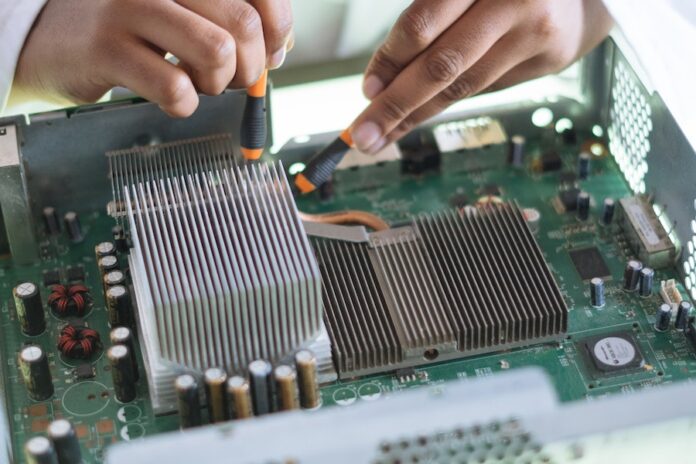Efficient CPU cooling is vital for maintaining the optimal performance and longevity of modern computer systems. In the relentless pursuit of enhanced cooling solutions, heat pipes have emerged as a game-changing technology. Heat pipes, with their exceptional heat transfer capabilities, have found their way into various CPU coolers, offering users a wide range of options. In this article, we will explore the world of CPU coolers with heat pipes, shedding light on the different types available, their advantages, and the factors to consider when selecting the ideal cooler for your computing needs. Whether you’re a casual user or an overclocking enthusiast, understanding the role of heat pipes in CPU cooling is essential for ensuring your computer runs smoothly.
Which type of CPU cooler contains heat pipes?
Various types of CPU coolers contain heat pipes to enhance thermal performance. These heat pipes are commonly found in air coolers, liquid coolers, and hybrid coolers. Air coolers typically integrate heat pipes within their fin stacks to efficiently dissipate heat. Liquid coolers often use heat pipes as their heat transfer mechanism, connecting the CPU block to the radiator. Hybrid coolers combine elements of both air and liquid cooling, with heat pipes playing a vital role in the heat transfer process. The presence of heat pipes helps these coolers maintain lower temperatures and improve overall CPU cooling performance.
Importance of CPU cooling
CPU cooling is a critical aspect of computer hardware that often goes underestimated in its importance. The central processing unit (CPU) is the brain of a computer, responsible for executing complex calculations and tasks. As it operates, the CPU generates a significant amount of heat due to the rapid movement of electrons through its transistors. This heat, if not effectively managed and dissipated, can have severe consequences for the computer system:
Heat is the enemy of electronic components, and excessive heat can lead to a decrease in CPU performance. Modern CPUs are designed to operate within specific temperature ranges. When the temperature exceeds these limits, the CPU may throttle its performance to prevent damage. This results in a slower computer, impacting productivity and gaming experiences.
Overheating can cause system instability, leading to crashes, freezes, and unexpected shutdowns. These issues not only disrupt work but can also lead to data loss in critical situations. An adequately cooled CPU ensures system stability and reliable operation.
Heat is a significant contributor to component wear and tear. Prolonged exposure to high temperatures can shorten the lifespan of the CPU and other sensitive hardware components, such as the motherboard and RAM. Adequate cooling helps extend the longevity of your computer, reducing the need for costly replacements or upgrades.
Inadequate cooling can lead to the CPU fan running at high speeds to compensate for increased temperatures. This results in elevated noise levels, which are distracting and annoying, especially in quieter environments. Efficient CPU cooling helps maintain lower fan speeds, reducing noise pollution.
Enthusiasts who seek to maximize CPU performance often turn to overclocking. Overclocking involves running the CPU at speeds higher than its default specifications, which generates more heat. Proper CPU cooling is essential for successful overclocking, allowing users to push their CPUs to higher speeds without overheating.
A well-cooled CPU operates more efficiently, consuming less power and reducing energy costs. This is particularly important for users who run computers continuously or in data centers where power consumption is a significant consideration.
Effective CPU cooling contributes to the overall health of the computer system. It prevents heat-related damage not only to the CPU but also to other critical components, such as the GPU (Graphics Processing Unit) and storage devices. This safeguards your investment in expensive hardware.
The basics of CPU cooling
CPU cooling is a fundamental aspect of computer hardware design and maintenance. It involves dissipating heat generated by the central processing unit (CPU) to ensure it operates within safe temperature limits. Here are the basics of CPU cooling:
Heat Generation: The CPU is the primary component responsible for executing instructions and calculations in a computer. As it performs these tasks, it generates heat due to the electrical resistance in its transistors. The more demanding the tasks, the more heat is produced.
Importance of Cooling: Heat is the enemy of electronic components, including the CPU. If the CPU temperature exceeds safe limits, it can lead to performance degradation, system instability, and, in extreme cases, permanent damage. Efficient CPU cooling is essential to maintain optimal performance and prevent overheating.
Air Cooling: Air cooling is the most common method of cooling CPUs. It typically involves a heatsink and a fan (often called a CPU cooler). The heatsink is a metal component with fins that help dissipate heat. The fan blows air over the heatsink, facilitating heat transfer and cooling. This process is adequate for most mainstream CPUs and is cost-effective.
Liquid Cooling: Liquid cooling is an advanced cooling method used by enthusiasts and high-performance systems. It involves a closed-loop system or a custom setup with a liquid coolant that circulates through a block attached to the CPU. The heat is transferred to the liquid, which then moves to a radiator, dissipating heat through a fan. Liquid cooling systems can offer superior cooling performance and can handle extreme overclocking.
Thermal Paste: To improve the thermal conductivity between the CPU and the heatsink or water block, a thermal paste or thermal compound is applied. This paste fills microscopic gaps between the CPU and cooler, ensuring efficient heat transfer.
Overclocking: Overclocking involves running the CPU at speeds higher than its default specifications. This results in increased heat generation. To overclock safely, an efficient cooling solution is crucial, as it helps dissipate the extra heat and prevents overheating.
TDP (Thermal Design Power): CPUs come with a TDP rating that indicates the maximum amount of heat they are designed to dissipate. When selecting a CPU cooler, it’s essential to choose one that can handle the CPU’s TDP to ensure proper cooling.
Case Airflow: Proper airflow within the computer case is also crucial for CPU cooling. Good cable management, strategically placed case fans, and adequate ventilation help ensure that cool air reaches the CPU cooler and that hot air is expelled efficiently.
Different Types of CPU Coolers with Heat Pipes
Air Coolers with Heat Pipes:
Air coolers are one of the most common CPU cooling solutions. They consist of a heatsink with a finned structure and one or more heat pipes. The heat pipes directly contact the CPU’s integrated heat spreader (IHS), efficiently transferring heat to the heatsink. The fan(s) attached to the heatsink then dissipates the heat into the surrounding air. Air coolers are known for their reliability, cost-effectiveness, and ease of installation. They come in various sizes and designs, catering to different cooling needs.
Liquid Coolers with Heat Pipes:
Liquid cooling systems, often called AIO (All-In-One) coolers, combine heat pipes and liquid coolant to cool the CPU. Heat pipes connect the CPU block to a radiator, which is equipped with fans. The liquid coolant absorbs the heat from the CPU and carries it to the radiator, where it dissipates into the air. Liquid coolers can provide excellent cooling performance, making them popular among gamers and overclocking enthusiasts. They are relatively easy to install and offer a cleaner look inside the PC case than air coolers.
Hybrid Coolers:
Hybrid coolers combine elements of both air and liquid cooling. They typically feature a CPU block with integrated heat pipes that connect to a liquid cooling loop, similar to AIO coolers. However, hybrid coolers also include a fan for additional airflow over the CPU block and VRM components on the motherboard. This combination allows for efficient cooling and is particularly useful for high-end CPUs and overclocking setups. Hybrid coolers offer versatility and robust cooling performance.
Low-Profile Coolers:
Low-profile CPU coolers with heat pipes are designed for small form factor (SFF) PCs and HTPCs (Home Theater PC). They are compact to fit in tight spaces but still incorporate heat pipes for effective heat transfer. These coolers often rely on smaller fans and heatsinks, making them suitable for systems where space is limited.
Tower Coolers:
Tower-style CPU coolers, both air and hybrid, feature a vertical heatsink with multiple heat pipes. These coolers are known for their efficiency and are often used in mid to full-sized PC cases. The vertical design allows for a larger surface area for heat dissipation, and the heat pipes ensure quick and effective heat transfer.
What Factors to Consider When Choosing a CPU Cooler with Heat Pipes?
When selecting a CPU cooler with heat pipes, several essential factors must be considered to ensure you choose the right cooling solution. Here are the key factors to keep in mind:
- The first and foremost consideration is CPU compatibility. CPU coolers are designed to fit specific CPU sockets, such as Intel LGA 1151 or AMD AM4. Ensure that the cooler you choose is compatible with your CPU socket to ensure a proper fit.
- CPUs come with a TDP rating that indicates the maximum amount of heat they can generate under load. It’s crucial to select a CPU cooler that can handle your CPU’s TDP comfortably. Choosing a cooler with a higher TDP rating than your CPU’s TDP is generally a good practice to ensure adequate cooling.
- The size and shape of your CPU cooler can affect its compatibility with your computer case. Ensure your selected cooler fits comfortably within your case without obstructing other components like RAM modules or airflow. More minor form factor cases may require low-profile coolers.
- The cooling performance of a CPU cooler is a critical factor, especially if you plan to overclock your CPU or use it for demanding tasks. Look for reviews and benchmarks to assess a cooler’s cooling efficiency under load conditions.
- The noise generated by CPU coolers can be a significant concern, especially in quiet or noise-sensitive environments. Check the noise level specifications (usually given in decibels or dB) and consider whether a quieter cooler is your priority.
- Decide whether you prefer an air cooler or a liquid cooler. Air coolers are generally more cost-effective and easier to install, but liquid coolers can provide better cooling performance, especially for high-end systems and overclocking.
Final Words
CPU cooling is a crucial component of any computer system, ensuring optimal performance, stability, and longevity. Heat pipes play a vital role in enhancing the efficiency of CPU coolers, making them a popular choice among users. When selecting a CPU cooler with heat pipes, consider factors such as CPU compatibility, TDP rating, form factor, cooling performance, noise levels, and your specific needs, whether they involve overclocking or quiet operation. A well-chosen CPU cooler will not only keep your processor running at ideal temperatures but also contribute to the overall health and longevity of your computer system. So, take your time to evaluate your options and make an informed choice to get the best cooling solution for your needs.
FAQ’s
What are heat pipes, and how do they work in CPU coolers?
Heat pipes are heat transfer devices that combine phase change (evaporation and condensation) and thermal conductivity to efficiently transport heat away from a heat source, such as a CPU. In CPU coolers, heat pipes transfer heat from the CPU to a heatsink or radiator for dissipation.
Are air coolers or liquid coolers better for CPU cooling?
The choice between air and liquid coolers depends on your needs and preferences. Air coolers are cost-effective and straightforward to install, while liquid coolers can offer better cooling performance, especially for high-end systems and overclocking.
What is the role of thermal paste in CPU cooling?
Thermal paste, or thermal compound, is applied between the CPU and the heatsink or water block in CPU coolers. Its role is to fill microscopic gaps and imperfections in the surfaces, ensuring optimal thermal conductivity and heat transfer between the CPU and cooler.





